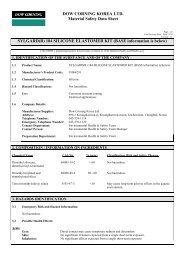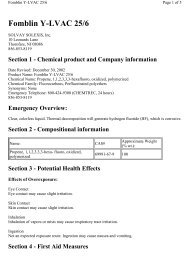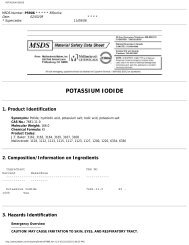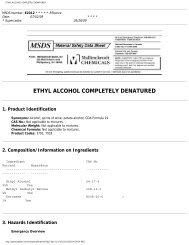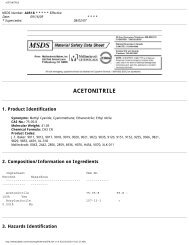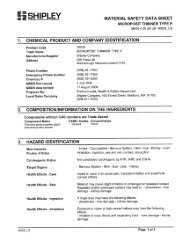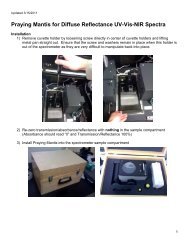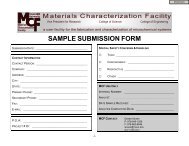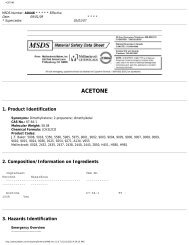ISOPROPYL ALCOHOL (90 - 100%)
isopropyl alcohol (90 - 100%) - Materials Characterization Facility
isopropyl alcohol (90 - 100%) - Materials Characterization Facility
- No tags were found...
Create successful ePaper yourself
Turn your PDF publications into a flip-book with our unique Google optimized e-Paper software.
<strong>ISOPROPYL</strong> <strong>ALCOHOL</strong> (<strong>90</strong> - <strong>100%</strong>)<br />
Flammable limits in air % by volume:<br />
lel: 2.0; uel: 12.7<br />
Listed fire data is for Pure Isopropyl Alcohol.<br />
Explosion:<br />
Above flash point, vapor-air mixtures are explosive within flammable limits noted above. Contact with<br />
strong oxidizers may cause fire or explosion. Vapors can flow along surfaces to distant ignition source and<br />
flash back. Sensitive to static discharge.<br />
Fire Extinguishing Media:<br />
Water spray, dry chemical, alcohol foam, or carbon dioxide. Water spray may be used to keep fire<br />
exposed containers cool, dilute spills to nonflammable mixtures, protect personnel attempting to stop leak<br />
and disperse vapors.<br />
Special Information:<br />
In the event of a fire, wear full protective clothing and NIOSH-approved self-contained breathing apparatus<br />
with full facepiece operated in the pressure demand or other positive pressure mode.<br />
6. Accidental Release Measures<br />
Ventilate area of leak or spill. Remove all sources of ignition. Wear appropriate personal protective equipment<br />
as specified in Section 8. Isolate hazard area. Keep unnecessary and unprotected personnel from entering.<br />
Contain and recover liquid when possible. Use non-sparking tools and equipment. Collect liquid in an<br />
appropriate container or absorb with an inert material (e. g., vermiculite, dry sand, earth), and place in a<br />
chemical waste container. Do not use combustible materials, such as saw dust. Do not flush to sewer! If a leak<br />
or spill has not ignited, use water spray to disperse the vapors, to protect personnel attempting to stop leak, and<br />
to flush spills away from exposures.<br />
J. T. Baker SOLUSORB® solvent adsorbent is recommended for spills of this product.<br />
7. Handling and Storage<br />
Protect against physical damage. Store in a cool, dry well-ventilated location, away from any area where the<br />
fire hazard may be acute. Outside or detached storage is preferred. Separate from incompatibles.<br />
Containers should be bonded and grounded for transfers to avoid static sparks. Storage and use areas should<br />
be No Smoking areas. Use non-sparking type tools and equipment, including explosion proof ventilation.<br />
Containers of this material may be hazardous when empty since they retain product residues (vapors,<br />
liquid); observe all warnings and precautions listed for the product. Small quantities of peroxides can form<br />
on prolonged storage. Exposure to light and/or air significantly increases the rate of peroxide formation.<br />
If evaporated to a residue, the mixture of peroxides and isopropanol may explode when exposed to heat or shock.<br />
8. Exposure Controls/Personal Protection<br />
Airborne Exposure Limits:<br />
For Isopropyl Alcohol (2-Propanol):<br />
-OSHA Permissible Exposure Limit (PEL): 400 ppm (TWA)<br />
-ACGIH Threshold Limit Value (TLV):<br />
200 ppm (TWA), 400 ppm (STEL), A4 - not classifiable as a human carcinogen.<br />
Ventilation System:<br />
A system of local and/or general exhaust is recommended to keep employee exposures below the<br />
Airborne Exposure Limits. Local exhaust ventilation is generally preferred because it can control the emissions<br />
of the contaminant at its source, preventing dispersion of it into the general work area. Please refer to the<br />
ACGIH document, Industrial Ventilation,<br />
A Manual of<br />
http://www.jtbaker.com/msds/englishhtml/I8840.htm (3 of 7) [2/12/2010 4:57:41 PM]



